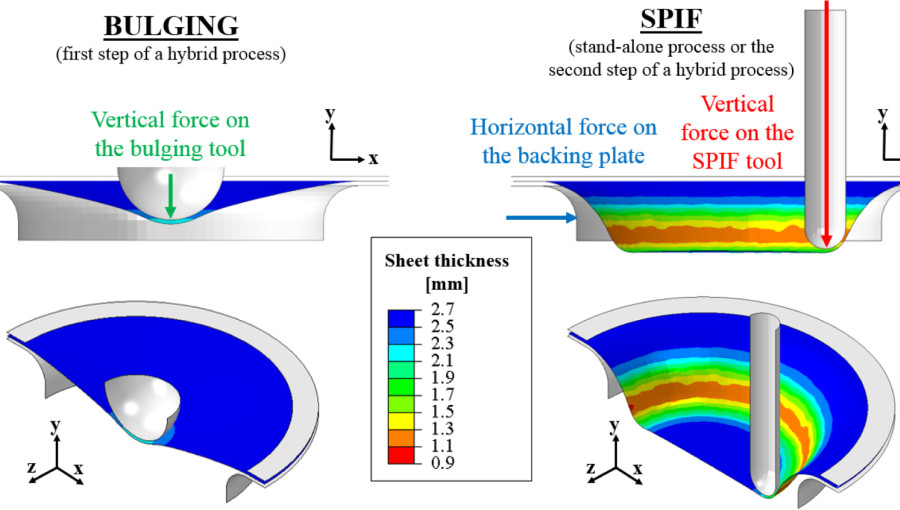The thin line of sheet metal forming

UL FS
Date of publication:
The production of thin-walled components from sheet metal is an integral part of the automotive, aerospace and other industries. Forming the initial sheet metal into the desired final shape of the product requires overcoming reaction forces and thinning of the sheet metal, which can lead to fractures. Knowing the influence of many parameters of the forming process allows controlled change of the shape of the workpiece, thus achieving the target shape of the final component.
Conventional forming processes require a unique tool shape that directly affects the shape of the final product. Since a new product design thus requires a new tool design, such processes can be very expensive. For this reason, incremental sheet metal forming processes, which use a small, simply designed tool and its path of motion to achieve any desired shape of the product, have become popular. The simplest form of the aforementioned group of forming processes is single-point incremental forming (SPIF), which uses a small, usually hemispherical tool to form a clamped sheet metal.
To achieve a more uniform wall thickness of the final product, the basic SPIF process can be upgraded by simply pre-bulging the sheet with a hemispherical tool. In order to evaluate the influence of the most important technological, geometrical and material parameters on the thinning of the sheet metal and the value of the reaction forces, the researchers of the Faculty of Mechanical Engineering, Laboratory for Forming (LAP), in cooperation with the Technical Faculty of the University of Rijeka, used the Random Forest method. The method itself makes it possible to determine the influence of individual parameters by analysing tree structures obtained through the training process.
The results of the study clearly indicate the critical input parameters of the discussed forming processes, to which special attention must be paid in order to reduce the thinning of the sheet metal and decrease the values of the reaction forces. The influence of both the target shape of the product and the geometry of the tool and the material of the workpiece with its thickness should be emphasized. Thus, depending on the desired shape of the product, it is necessary to select not only the technological parameters, but also the process itself. In certain cases of the desired product shape, bulging prior to incremental forming is not necessary in order to obtain a more uniform product wall thickness as well as lower force values. This information is important both for the desire to shorten the production cycle of any given part shape and for the goal of energy savings.
Authors of the article: Luka Sevšeka, Sandi Baressi Šegotab, Zlatan Carb, Tomaž Pepelnjaka
aForming Laboratory, Faculty of Mechanical Engineering, University of Ljubljana
bFaculty of Engineering, University of Rijeka, Croatia
The authors acknowledge the financial support from the Slovenian Research Agency [research core funding No. P2-0248, Project No. J2-2511] and from the European Regional Development Fund under the grant KK.01.1.1.01.0009 (DATACROSS). The authors also express thanks to the CEEPUS programme in the frame of network HR-0108.
SEVŠEK, Luka, ŠEGOTA, Sandi Baressi, CAR, Zlatan, PEPELNJAK, Tomaž. Determining the influence and correlation for parameters of flexible forming using the random forest method. Applied soft computing. [Print ed.]. Jun. 2023, str. 1-36, ilustr. ISSN 1568-4946. https://www.sciencedirect.com/science/article/pii/S156849462300515X, DOI: 10.1016/j.asoc.2023.110497. [COBISS.SI-ID 156012547]



